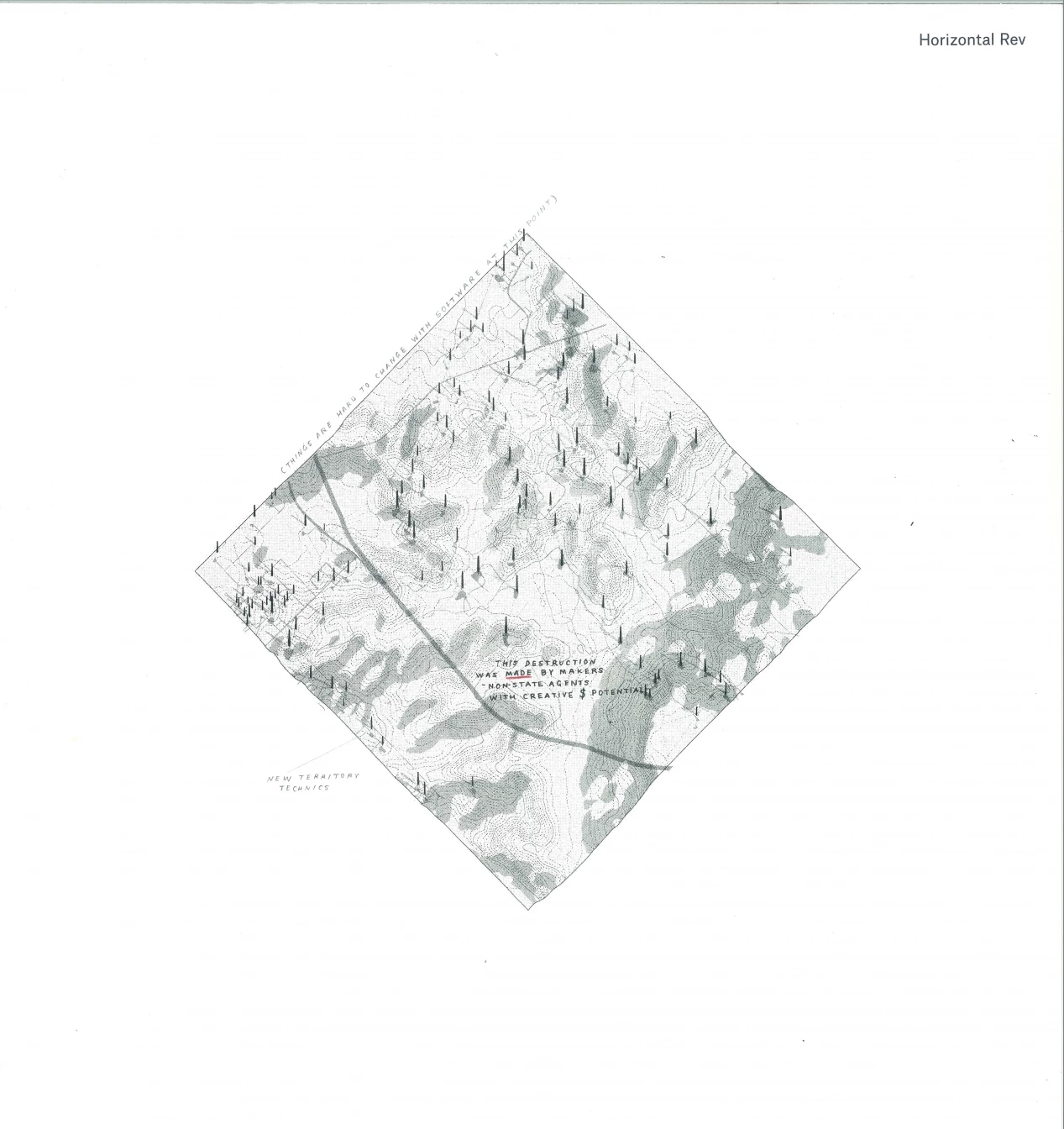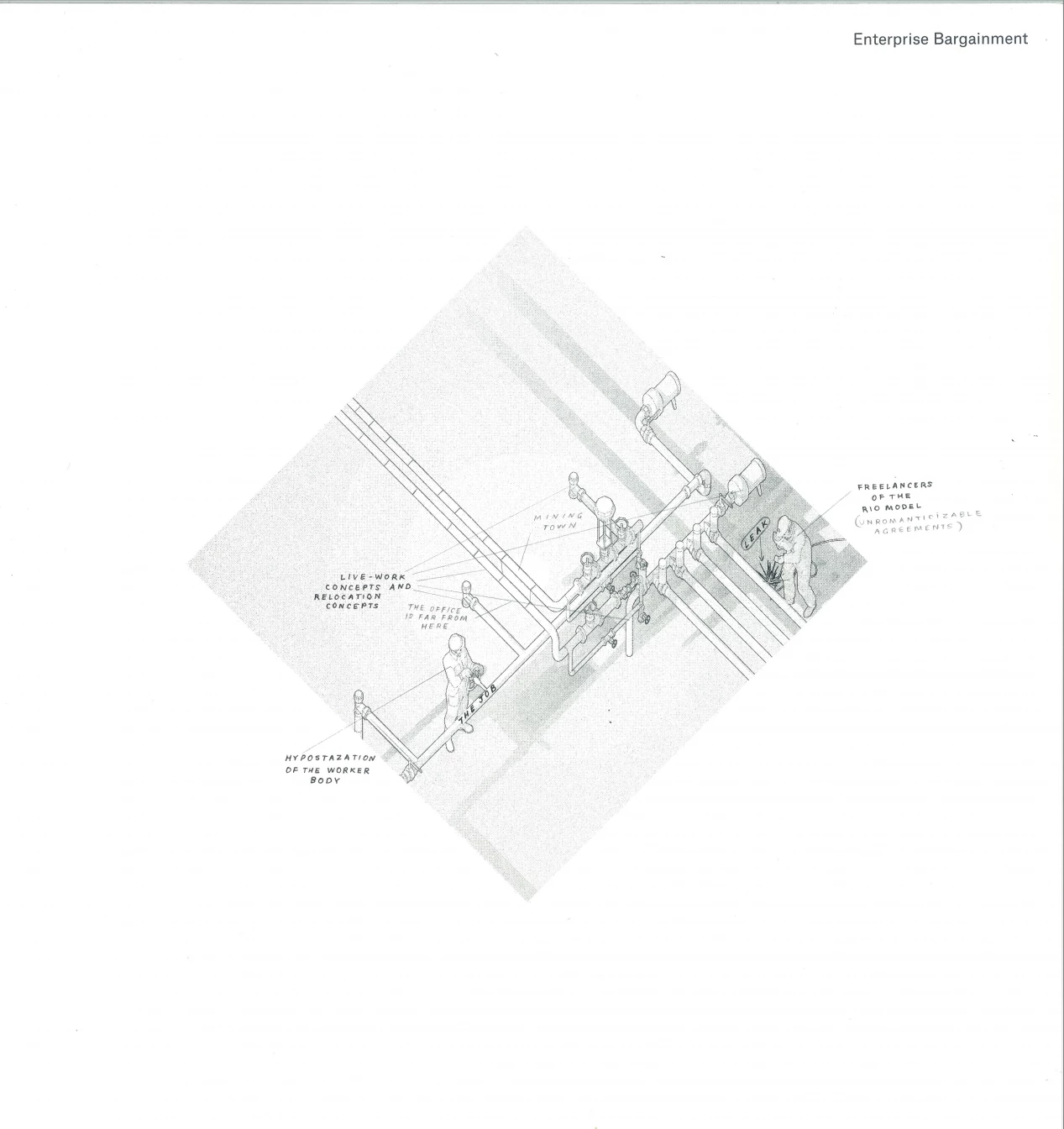
Horizontal Rev, from Rachel O'Reilly, The Gas Imaginary, iteration #2 (2014), with Rodrigo Hernandez and Pa.La.C.e. (Valle Medina and Benjamin Reynolds). Limited edition series of 9 x 3D drawings, risograph on paper, ink, pencil. Courtesy the artist.
This is the second part of an interview between curator Vivian Ziherl and writer, artist, curator and critic Rachel O'Reilly for L'Internationale Online. Part 1 discussed the implications of the term "decolonisation" as it is used within current contemporary art and European museum discourse, such as among the L'Internationale network in their concern with "decolonising practices". Part 2 departs from a specifically Antipodean (Australian and New Zealand) case of the symbolic and material politics of decolonisation.
Vivian Ziherl: Within my early drafting of the curatorial proposition Frontier Imaginaries, I attempted to align the notion of 'decolonisation' with a possible agenda of 'de-neoliberalisation'- in the effort of foregrounding a subjective and domestic register to the political, organisational and economic processes you mention. We recently discussed an article by Miri Davidson in The New Inquiry1 that addressed New Zealand Prime Minister John Key's agenda to remove the Union Jack from the national flag. You commented that for you, this gesture showed up certain limitations in the proliferation of the term 'decolonisation'. Could you expand upon that in this connection?
Rachel O'Reilly: We talked about how different forms of such statements are observable in much settler colonial state management of the last two decades. Davidson's great article gives a political coherence to the interests of the New Zealand Prime Minister in changing the national flag and removing the coloniser's insignia. "It's my belief," said Key, "and I think one increasingly shared by many New Zealanders, that the design of the New Zealand flag symbolises a colonial and postcolonial era whose time has passed." As Davidson traces it, the flag design proposition follows quite directly from Key's 2008 election campaign promise to achieve "full and final" settlements between the Crown and all iwi tribe, on all land theft matters that have breached the Treaty of Waitangi.2
So I was again raising questions about the relationship of (neoliberal) policy to processes of subsumption. Changing the flag and ending restitution 'finally' legislates white wishfulness for the end of Bad History, as also a kind of 'de'. Less extreme forms of such investments in moral-but-not-material 'clean-up' tend to (purposefully) confuse difficult, untended historical work with policy, such that political practices or tactics can be nominalised at the level of capital's own modes of production. In Key we see how a propositional politics of speech inherited from a period of 'more' representational democracy but not of it, veers immediately towards subsumption in this sense, showing up also the rearrangement of desire in right populist politics. The individuated desire to formally 'decolonise' reveals in (ficto-)liberal citizenship a demolition of the stakes of/for anything resembling the concept. Important to emphasize, Miri Davidson is articulating a non-indigenous occupied/occupier reflexivity around this.
Vivian Ziherl: What do you mean by "rearrangement of desire in populist politics"? That the symbolic effects (of rearranging a national flag's composition) are radically undercut by their material reality (ie. lack of change in racialised economic composition)?
Rachel O'Reilly: In the other direction. At the level of the subject, right populist desire, exacerbated by neoliberal restructuring, tends to be about individuated satiation and losses, a preoccupation with how the state has blocked or failed one's sense of freedom, in raised competition with others. It tends to spare no thought for the actual workings of infrastructure and provisioning, nor amid heightened competition, of how care for the other (which was inherent to 'welfare' statist concepts) might be distinguished from 'owned' private wishes for good feeling about the state's (or society's, this confusion) non/utility 'for you'. Key, wanting to be the author of an emotional transubstantiation—something like a Southern Thatcheresque 'we are all post-post-colonial now'—and framing that as an immaterial aim or achievement for a 'people' experiencing less redistributive policy otherwise, is a particularly characteristic operation of affect in right populist politics.

Enterprise Bargainment, from Rachel O'Reilly, The Gas Imaginary, iteration #2 (2014), with Rodrigo Hernandez and Pa.La.C.e. (Valle Medina and Benjamin Reynolds). Limited edition series of 9 x 3D drawings, risograph on paper, ink, pencil. Courtesy the artist.
This relationship between affect and neoliberalisation is also at play in the embrace of the neoconservative Australian government's Recognise campaign, to write Indigenous peoples into the Constitution.3 How can a liberal be against this word or 'recognition' etcetera, it sounds very basic good manners. Apart from pointing out the obvious fact that this kind of neo/liberal 'emotional' investment in (limits of) indigeneity is possible only because of being built directly on the partial material successes (and non-crediting) of autonomous indigenous political work, survivance, thriving, the larger point I was making about the concepting of 'only-administrative decolonisation' (as de-historicisation) here is that discourses are situated and ever re-authored – also along cognitive capitalist lines – and so constantly being transformed by practices and regimes. Recognise appears in the wake of the NT intervention, co-occurs with masses of evictions from traditional lands and private property (into jails), and with material derigistrations of sacred sites opening to mining etc, so in a dialectical continuity with a history of non-recognition (terra nullius) in this sense.
Vivian Ziherl: Your own poetry, drawings and research within Gas Imaginaries explores the aesthetic and political imagination of fracking or 'unconventional extraction', including in Queensland where the industry is being rolled out upon a mass scale. Where does that project, and its unfamiliar or 'unconventional' topographies fit into the conversation we are having here? It seems that an important question subtending this exchange is how to grasp 'decolonisation' as a discourse that can be most meaningfully responsive to particular neo/imperial processes that are ongoing over particular territories and bodies. I find this tendency present in your focus upon a possible poetics that run counter to the capitalist-realist poiesis of contracting, for example. Can you say something about this?
Rachel O'Reilly: I talk about The Gas Imaginary as a research project in poetics, tracking the forms and norms of 'unconventional' extraction, but more specifically of fracking, and its continuity with and differencing from modernist mining, as it rolls out internally to the indebted settler colonial states of the West (from its Halliburton centre). The first series of drawings, produced with P.a.L.a.C.e. architects Valle Medina and Ben Reynolds, and artist Rodrigo Hernandez, exhibit Mine and Mine work concepts between the Modern and Postmodern (fracking). As a narrative series it kind of dramatises the 'situation' of unconventional gas extraction to be both site-specific, and site-generalising. Involved in all that is a de-personalisation of the autobiographics - which is more possible through collaboration.

Citizenship Topsoil, from Rachel O'Reilly, The Gas Imaginary, iteration #2 (2014), with Rodrigo Hernandez and Pa.La.C.e. (Valle Medina and Benjamin Reynolds). Limited edition series of 9 x 3d drawings, risograph on paper, ink, pencil. Courtesy the artist.
My writing on installation art and my prioritisation of my own experimental writing led me here, as much as my oikonomic/paternal proximity to labour histories and mining (but more port) territories in Queensland. So I'm interested in fracking as a large scale installation project or corporate land art, one that gets installed from desktop studies, computational images and speculative (financialised) linguistics, to reshape the imagination of mining, away from modernist models, but reliant on that era's inherited tropes for it to be perceived as socially viable. It is only after install that those affected comprehend the difference of the legal forms, biopolitical impacts, and rhizomatic territorial power of the 'unconventional' mine contract (still the difference is not categorical but relative).
To the extent that such projects are installed through excepted 'special economic zonings', do not obey such borders in their effects, and are so inspiring of species existentialism, there is a kind of trauma that you can observe of a formerly protected (white) liberal settler colonial citizenship that has farmers (of all political persuasions) and treechangers,4 alongside everyday fisherman, religious conservatives and liberal environmentalists understanding—because being overexposed to—accumulation processes and the injustices of neocolonial land transfers 'as if' for the first time. Affected groups' emergent collective relating to the negatively commoned state of things often (though not majoritively or consistently) moves—when it does—beyond defense of the property form in styles of speech that are uncannily similar to that of the lyric poet. That's not my work, but that is the kind of relationship between language and installation that I'm talking about. In the settler colony, and also in the Blochian sense,5 we do not (ever) share the same time on the mine, which is (also) why divestment is perceived by some as a floppy 'one-hit' liberal cognition when prioritised on its own; but people are also being 'turned' away from older naturalised classed and raced attachments to energy industries, we must understand, because the scale and impact of the new forms are so clearly unprecedented,6 while the level of regulation has become manifestly pre-modern.
In parallel to the semi-autobiographical aspect of the work, the artistic research of The Gas Imaginary actually came together most clearly for me when I was travelling to and from Gladstone, post-Global Financial Crisis, at the height of the (unaffected) construction boom for the new gas port, while the harbour was being ruinously dredged.7 It was my abreactions to the extreme ossifications of language and vocabulary at the greenwashed public meetings that I was attending about the harbour's situation—as we shuffled around variously sacrificable nature-items on maps within boom and growth norms, in a fascinating anti-scientific and deeply aesthetic outsourcing of concessions about 'liveability' to 'the people'—which initially (dis)organised my own responsiveness at the level of language (I started writing the poems right then). The project since takes up different media formats (poetry, installation, drawing, also theory) and different analytical distances from the initial site, depending on which aspect of the research I'm grappling with. Of course, speaking back to engineered expertise and corporate science inherently manifests as quite dark and impotent, also a coping comedy, for a supposed 'woman' poet, failing to be speaking authoritatively into mega-industrially scaled space. The drawings and the poems are blue operations mainly in that sense (affect specific and internal to Boom),8 while still conjuncting tragedy's ekphrases with the inventive formalisms of political movements.9 If that was all I was doing with the material I'd be basically administrating aesthetics just like any other vectorial extraction of (dis/)content into global art (or poetry) space; but translating so-called artistic research into meaningful engagements with so-called workers for and against the mine, through different educational, political and other non-art spaces, alongside the contemporary and regional art institutional displays, is really the challenge.